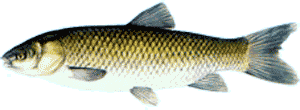- Details
- Hits: 4860
Grass Carp Facts
(Ctenopharyngodon idella)
Grass carp are a large member of the minnow family and are related to common carp and goldfish. However, their appearance is quite unlike other carp, aside from their large scales. Grass carp are generally a dark colour on the back that ranges from gray to green, dark olive, golden brown or bronze. The colour fades to a light brown-yellow or silver on the side before becoming white on the belly. Fins are clear to dark in colour.
They have a long, torpedo shaped body that resembles that of the chub, only much larger. The body is covered with large scales, of which 40 to 42 make up the lateral line. The upper-side scales have a dark fringe and black spot that often give the grass carp a checkered look.
Grass carp have a broad, rounded head with a short snout
Compared with other carp, the large eyes are set relatively low on the head. The mouth is located at the end of the head and has thin, rounded lips. Their mouths are clearly smaller than those of other carp. For easy identification purposes, grass carp do not have the barbels found around the mouths of other carp.
The common name of the grass carp is "white amur", which comes from the Amur River in Asia, where it is believed that grass carp originated from.
Because of their unique spawning habitat requirements, grass carp can only spawn naturally in few areas outside their native range. As a result, where they have been introduced, stocking programs are critical to maintaining their numbers.
They were first exported out of Asia in an effort to exploit their feeding habits for weed control purposes in selected waters.
Grass carp are exclusively a freshwater species that inhabits primarily temperate lakes, ponds, and large river backwater areas. They prefer areas with slow current or standing water that is teeming with vegetation.
They are very adaptable and can endure variations in temperature, salinity and low oxygen levels. In relation to water temperature, they are known to be able to adapt to water ranging from 32 to 100 F.
Grass carp are very particular about their spawning areas and habits. The eggs of the grass carp are heavier than water and thus require a relatively strong current in order to hatch. As a result, they are unable to spawn in lakes, ponds, and even many of the rivers in which they are introduced.
Grass carp are almost exclusively vegetarian. As a result of this vegetarian nature, they almost never compete with popular game fish or commercial fish for food sources.
Their name comes from their almost exclusive diet of aquatic grasses and weeds. Occasionally they will eat small insects, and invertebrates. Grass carp are capable of eating several times their own weight in vegetation each day.
Those who fish for grass carp are generally rewarded because they are strong fish that can put up quite a fight. They are even known to occasionally jump when hooked, make repeated runs and seem willing to do whatever they can muster to prevent being landed. Fishing methods are similar to those used for any carp.
























